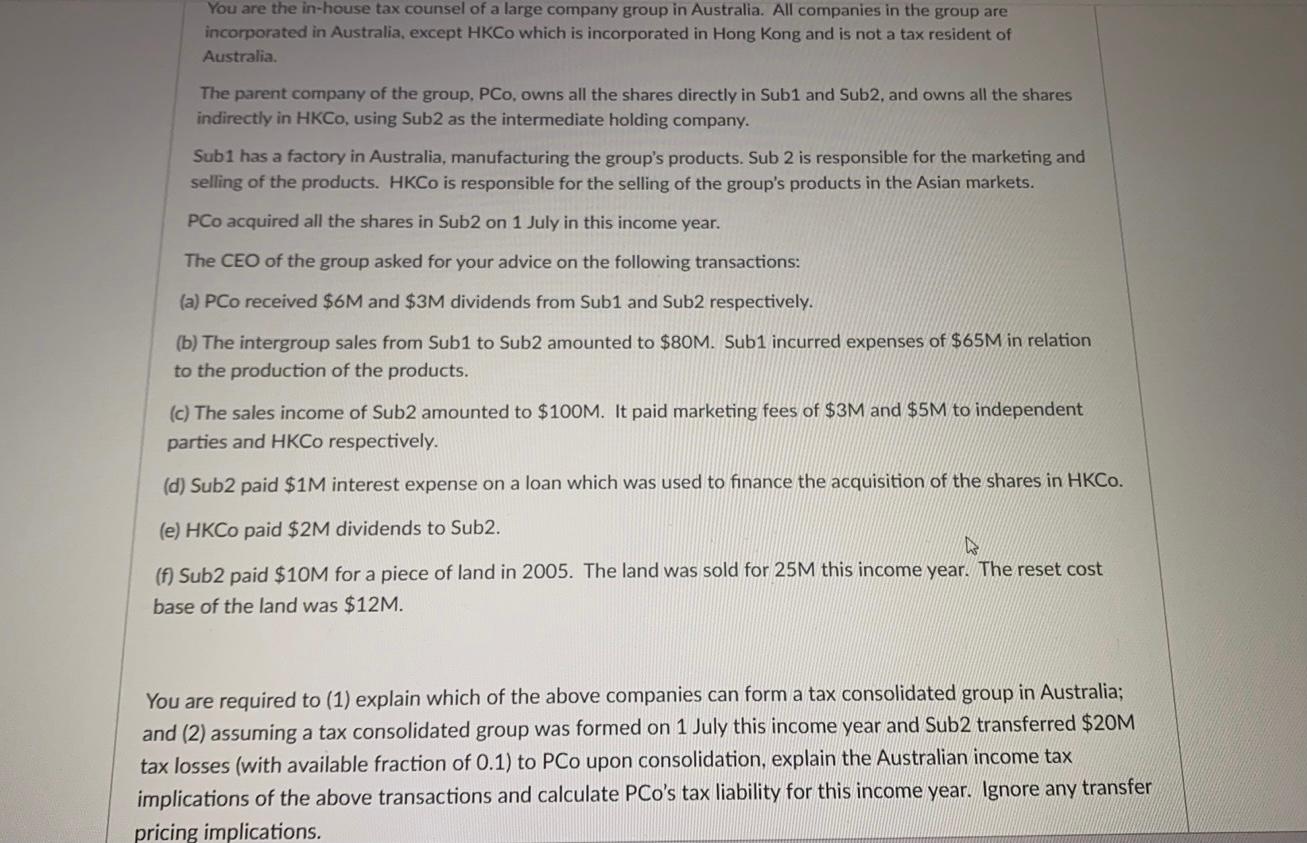 Do it quickly please, CLAW taxes
Do it quickly please, CLAW taxes
You are the in-house tax counsel of a large company group in Australia. All companies in the group are incorporated in Australia, except HKCo which is incorporated in Hong Kong and is not a tax resident of Australia. The parent company of the group, PCo, owns all the shares directly in Sub1 and Sub2, and owns all the shares indirectly in HKCo, using Sub2 as the intermediate holding company. Sub1 has a factory in Australia, manufacturing the group's products. Sub 2 is responsible for the marketing and selling of the products. HKCo is responsible for the selling of the group's products in the Asian markets. PCo acquired all the shares in Sub2 on 1 July in this income year. The CEO of the group asked for your advice on the following transactions: (a) PCo received $6M and $3M dividends from Sub1 and Sub2 respectively. (b) The intergroup sales from Sub1 to Sub2 amounted to $80M. Sub1 incurred expenses of $65M in relation to the production of the products. (c) The sales income of Sub2 amounted to $100M. It paid marketing fees of $3M and $5M to independent parties and HKCo respectively. (d) Sub2 paid $1M interest expense on a loan which was used to finance the acquisition of the shares in HKCo. (e) HKCo paid \$2M dividends to Sub2. (f) Sub2 paid \$10M for a piece of land in 2005. The land was sold for 25M this income year. The reset cost base of the land was $12M. You are required to (1) explain which of the above companies can form a tax consolidated group in Australia; and (2) assuming a tax consolidated group was formed on 1 July this income year and Sub2 transferred \$20M tax losses (with available fraction of 0.1) to PCo upon consolidation, explain the Australian income tax implications of the above transactions and calculate PCo's tax liability for this income year. Ignore any transfer pricing implications. You are the in-house tax counsel of a large company group in Australia. All companies in the group are incorporated in Australia, except HKCo which is incorporated in Hong Kong and is not a tax resident of Australia. The parent company of the group, PCo, owns all the shares directly in Sub1 and Sub2, and owns all the shares indirectly in HKCo, using Sub2 as the intermediate holding company. Sub1 has a factory in Australia, manufacturing the group's products. Sub 2 is responsible for the marketing and selling of the products. HKCo is responsible for the selling of the group's products in the Asian markets. PCo acquired all the shares in Sub2 on 1 July in this income year. The CEO of the group asked for your advice on the following transactions: (a) PCo received $6M and $3M dividends from Sub1 and Sub2 respectively. (b) The intergroup sales from Sub1 to Sub2 amounted to $80M. Sub1 incurred expenses of $65M in relation to the production of the products. (c) The sales income of Sub2 amounted to $100M. It paid marketing fees of $3M and $5M to independent parties and HKCo respectively. (d) Sub2 paid $1M interest expense on a loan which was used to finance the acquisition of the shares in HKCo. (e) HKCo paid \$2M dividends to Sub2. (f) Sub2 paid \$10M for a piece of land in 2005. The land was sold for 25M this income year. The reset cost base of the land was $12M. You are required to (1) explain which of the above companies can form a tax consolidated group in Australia; and (2) assuming a tax consolidated group was formed on 1 July this income year and Sub2 transferred \$20M tax losses (with available fraction of 0.1) to PCo upon consolidation, explain the Australian income tax implications of the above transactions and calculate PCo's tax liability for this income year. Ignore any transfer pricing implications
 Do it quickly please, CLAW taxes
Do it quickly please, CLAW taxes 





